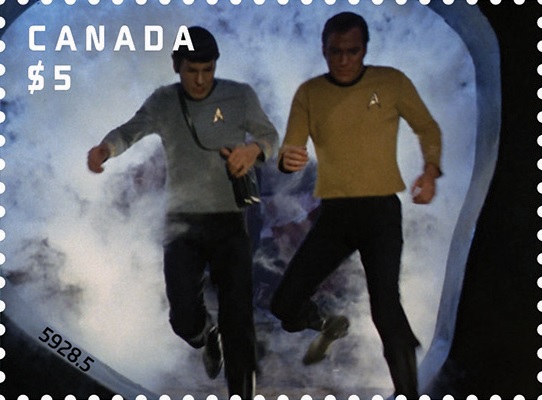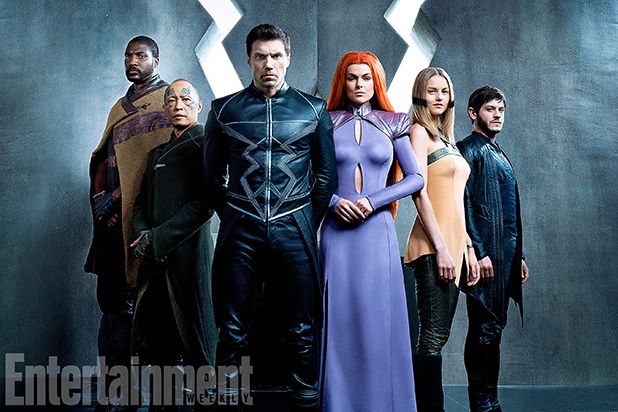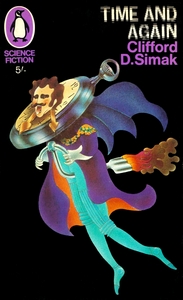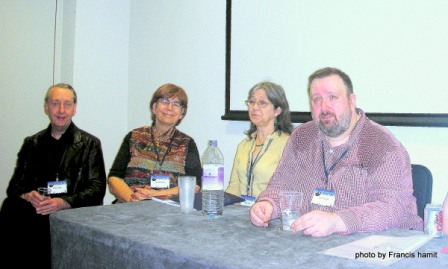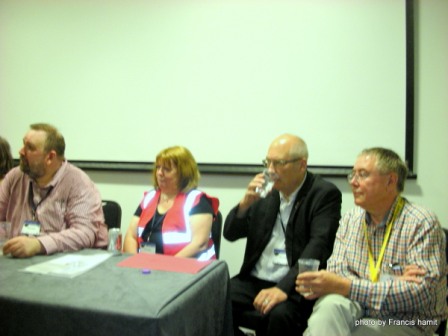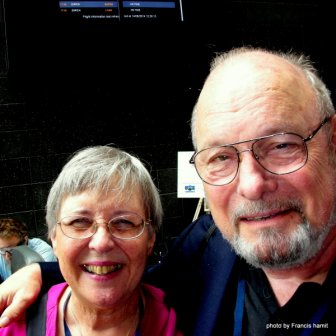(1) THE GREAT UNREAD. James Davis Nicoll fesses up – now you can, too: “Twenty Core Speculative Fiction Works It May Surprise You To Learn I Have Not Yet Read Every True SF Fan Should Have On Their Shelves”. Who knew there were 20 sff books altogether than he hadn’t read, much less ones not by Castalia House authors? Here are a few examples:
- Re: Colonised Planet 5, Shikasta by Doris Lessing
- The Grace of Kings by Ken Liu
- England Swings SF edited by Judith Merril
(2) MOVING DAY. Meanwhile, at another of his platforms, James Davis Nicoll has gone silent while he works on moving that website.
Why was my site down? Because it turns out the soft-on-Nazis fuckwits running DreamHost thought it would be a good idea to host the Daily Stormer. My site will be moving. Until it has been moved, I won’t be updating it; I will go back to posting reviews on DW.
(3) GENRE TENSIONS. Here’s what Teleread’s Paul St. John Mackintosh deemed to be the takeaway from an all-star panel at Helsinki: “Worldcon 75: Horror and the World Fantasy Award”.
[Stephen] Jones pointed to the origins of the WFA Awards and their parent convention, the World Fantasy Convention, during the horror boom of the mid-1970s. The first WFC, held in Providence, RI in 1975, had as its theme “The Lovecraft Circle,” and that Lovecraftian association has persisted ever since, despite the name on the billboard. Jones attributed the perceived bias towards horror at fantasy and other conventions to the view that “the horror guys the people who go to all the fun conventions.” [Ellen] Datlow, conversely, reported that “from the horror people’s point of view, in the past ten years, they always feel there’s a bias towards fantasy.” Her analysis of actual awards and nominations showed no bias either way, and she saw this as “all perception,” depending on which end of the imaginative literature spectrum it’s seen from. [John] Clute described the situation as “pretty deeply confusing altogether,” given that the WFC externally was intended as a fantasy convention, and the final result has become “terminologically inexact,” though Jones pointed out that “the community itself has changed and mutated, as has the genre.”
(4) VOICE OF EXPERIENCE. Simon Owens reveals “What’s behind the meteoric rise of science fiction podcasts?” – and these are just the drama podcasts, never mind all the nonfiction ones…
According to Valenti, a serialized fiction podcast is an inexpensive way for aspiring filmmakers to gain recognition in the industry. “The reason you’re seeing all these shows crop up is because it’s so much less expensive to experiment and prove yourself as a storyteller in this medium, more than any other,” he said. It used to be that Hollywood directors got their foot in the door with short, independent films, but even those kinds of projects require significant resources. “With podcasts, you don’t have to spend any money on locations,” he explained. “You don’t have to spend any money on cameras, hardware, or hiring a cinematographer. And even if you have the footage, and you had a decent camera, which you probably had to rent because they cost thousands of dollars a day, you’re getting someone to color grade everything after it’s over.” Podcasts rarely require anything more than decent mics, actors, and audio mixing technology. And speaking of actors, your average voiceover performer costs much less to hire than a SAG member.
(5) INKY AWARDS. The shortlists for the 2017 Inky Awards were announced August 15 – the Gold Inky for Australia titles, and the Silver Inky for international titles. The award recognises achievement in young adult literature, with nominees and winners selected by voters under the age of 20. Some of these titles are of genre interest. Voting is currently open for the winners. [H/T Earl Grey Editing Services.]
(6) MORE WORLDCON WRITEUPS. The conreports keep on coming.
Kelly Robson: “What it’s like to lose a Hugo Award”
The Campbell was the second-to-last award, and sure, I was disappointed not to win, but not horribly. On a scale of one to ten, it was about a three at the time and now is zero. I’m very happy for Ada. She deserves every success.
However, I did feel foolish for thinking I could win, which was painful but mostly dispersed by morning. Being a finalist is wonderful. Winning would have been amazing, but it does come with a certain amount of pressure. So maybe — just maybe — being a finalist is the best of both worlds. And that lovely pin in the first picture is mine forever.
Ian Sales: “Kiitos, Helsinki”
My second panel of the con was at noon on the Saturday, Mighty space fleets of war. When I’d registered at the con, I’d discovered I was moderating the panel, which I hadn’t known. I checked back over the emails I’d been sent by the con’s programming team. Oops. I was the moderator. The other two panellists were Jack Campbell and Chris Gerrib. As we took our seats on the stage, Mary Robinette Kowal was gathering her stuff from the previous panel. I jokingly asked if she wanted to join our panel. And then asked if she’d moderate it. She said she was happy to moderate if we wanted her to, but we decided to muddle through ourselves. The panel went quite well, I thought. We got a bit of disagreement going – well, me versus the other two, both of whom admitted to having been USN in the past. I got a wave of applause for a crack about Brexit, and we managed to stay on topic – realistic space combat – for the entire time. I’d prepared a bunch of notes, but by fifteen minutes in, I’d used up all my points. In future, I’ll take in paper and pencil so I can jot stuff down as other members of the panel speak.
Marzie: “The Long Overdue WorldCon Recap!”
This was the first WorldCon I’ve attended and while I had voted in previous Hugo Awards, and attended other Cons (for instance NYCC) I was kind of taken aback by how non-commercial WorldCon is. A case is point is that there are no publishers hawking books at WorldCon, which, on the one hand is great because you don’t get tempted to buy a bunch of stuff and spend a fortune shipping it home and on the other hand is bad because if you’ve travelled a long way with a carry-on only bag, you’re probably packing clothes, not books for your favorite author to sign. Some authors take it all in stride, bringing their own small promotional items they can sign (Fran Wilde, Carrie Vaughn) or will happily sign anything that you set in front of them (Max Gladstone kindly signed a WorldCon postcard for my friend and fellow blogger Alex, who couldn’t come to WorldCon because of Fiscal Realities of New Home vs. Sincere Desire. So other than some interesting panels (climate change in science fiction and fantasy, readings by Amal El-Mohtar and Annalee Newitz, while I can say that pigeonholing fantasy genres is not for me!) the author signings and beloved kaffeeklatsches, the latter limited to ten people, are the definitely the most exciting thing about WorldCon.
Ian Moore: “Helsinki Worldcon write-up Part 1: estrangement, We3, crowds”
Tomi Huttunen introduced the concept of Estrangement, which derives from Russian art theorist Viktor Shklovsky who discussed the topic (Ostrananie) in an article in 1917. Huttunen and others on the academic track offered varying definitions of the concept, noting that different people in the past had come at this in a different way. For all that he was someone primarily associated with the avant-garde, Shklovsky’s own definition appeared to imply that all art involved a process of estrangement because of the difference between an actual thing and its artistic representation. Brecht later attempted his own definition, which appeared to be more about uncanny valley or the German concept of the unheimlich, which I found interesting as for all his ground-breaking approach to theatre Brecht had not particularly involved himself in work that strayed into non-realistic territory.
“Helsinki Worldcon write-up Part 2: Saunas, Robert Silverberg & Tanith Lee #Worldcon75”
On Thursday I did not quite get up in time to make it from where I was staying to the convention centre in time for the presentation on Tove Jansson’s illustrations for The Hobbit (which apparently appear only in Scandinavian editions of the book for Tolkien-estate reasons). I did make it to a panel on Bland Protagonists. One of the panelists was Robert Silverberg, a star of Worldcon and a living link to the heroic age of Science Fiction. He is a great raconteur and such an entertaining panelist that I wonder whether people do not want to appear on panels with him for fear of being overshadowed.
“Helsinki Worldcon write-up Part 3: Moomins, Clipping #Worldcon75”
After the Tanith Lee discussion there were a lot of potentially interesting things happening but we felt that we had to go to a session on the Moomins (entitled Moomins!). As you know, these are character that appeared in books written and illustrated by Tove Jansson of Finland. They started life in books and then progressed to comics and subsequently to a succession of animated TV series. If you’ve never heard of them, the Moomins are vaguely hippopotamus shaped creatures that live in a house in Moominvalley and have a variety of strange friends and adopted family members. Moomin stories are pretty cute but also deal with subjects a bit darker and more existential than is normally expected in children’s books.
(7) ROBOCRIMEVICTIM. It is a lawless country out there: “Popular Robots are Dangerously Easy to Hack, Cybersecurity Firm Says”.
The Seattle-based cybersecurity firm found major security flaws in industrial models sold by Universal Robots, a division of U.S. technology company Teradyne Inc. It also cited issues with consumer robots Pepper and NAO, which are manufactured by Japan’s Softbank Group Corp., and the Alpha 1 and Alpha 2 made by China-based UBTech Robotics.
These vulnerabilities could allow the robots to be turned into surveillance devices, surreptitiously spying on their owners, or let them to be hijacked and used to physically harm people or damage property, the researchers wrote in a report released Tuesday.
(8) TODAY’S DAY
Pluto Demoted Day
Many of us are fascinated by outer space and its many mysteries. Our own solar system went through a change in classification on 2006, when Pluto was demoted from a planet to a dwarf planet. Pluto Demoted Day now takes place every year to mark that very occasion. While sad for fans of the former ninth planet of the solar system, Pluto Demoted Day is an important day for our scientific history and is important to remember.
(9) TODAY IN HISTORY
- August 24, 1966 — Fantastic Voyage premiered theatrically on this day.
(10) TODAY’S BIRTHDAY BOY
- Born August 24, 1951 – Orson Scott Card
(11) COMIC SECTION. Finnish comic Fingerpori has a joke about the George R.R. Martin signing at W75. Tehri says it translates something like this (with the third frame being a sight gag):
First panel: (The guy’s name is Heimo Vesa) “What’s going on?”
“George R.R. Martin’s signing queue.”
Middle panel: “Well, I must experience this”.
(As in once in a lifetime thing.)
And Mike Kennedy says today’s Dilbert Classic confirms that publishers exist in order to stomp on potential author’s dreams.
(12) SHE HAS A LITTLE LIST. Kayleigh Donaldson asks “Did This Book Buy Its Way Onto The New York Times Bestseller List?” at Pajiba.
Nowadays, you can make the bestseller list with about 5,000 sales. That’s not the heights of publishing’s heyday but it’s still harder to get than you’d think. Some publishers spend thousands of dollars on advertising and blogger outreach to get that number. Everyone’s looking for the next big thing and that costs a lot of cash. For the past 25 weeks, that big book in the YA world has been The Hate U Give by Angie Thomas, a searing politically charged drama about a young black girl who sees a police officer kill her friend, and the fallout it causes in her community. Through publisher buzz and exceedingly strong word of mouth, the novel has stormed to the forefront of the YA world and found thousands of fans, with a film on the way. Knocking that from the top of the NYT YA list would be a major deal, and this week it’s going to happen. But something’s not right.
Handbook For Mortals by Lani Sarem is the debut novel from the publishing arm of website GeekNation. The site announced this news only last week, through a press release that can be read on places like The Hollywood Reporter, not a site known for extensive YA coverage. Sarem has an IMDb page with some very minor acting roles, several of which are uncredited, but details on the book are scanter to find. Googling it leads to several other books with the same title, but most of the coverage for it is press release based. There’s little real excitement or details on it coming from the YA blogging world, which is a mighty community who are not quiet about the things they’re passionate about (believe me, first hand experience here).
YA writer and publisher Phil Stamper raised the alarm bells on this novel’s sudden success through a series of tweets, noting GeekNation’s own low traffic, the inability to even buy it on Amazon or Barnes & Noble, and its out-of-nowhere relevance…
(13) AMAZONIAN BOGOSITY. While reporters are dissecting the bestseller list, Camestros Felapton turns his attention to Amazon and the subject of “Spotting Fakery?”
One thing new to me from those articles was this site: http://fakespot.com/about It claims to be a site that will analyse reviews on sites like Amazon and Yelp and then rate the reviews in terms of how “fake” they seem to be. The mechanism looks at reviewers and review content and looks for relations with other reviews, and also rates reviewers who only ever give positive reviews lower. Now, I don’t know if their methods are sound or reliable, so take the rest of this with a pinch of salt for the time being.
Time to plug some things into their machine but what! Steve J No-Relation Wright has very bravely volunteered to start reading Vox Day’s epic fantasy book because it was available for $0 ( https://stevejwright.wordpress.com/2017/08/23/a-throne-of-bones-by-vox-day-preamble-on-managing-expectations/ ) and so why not see what Fakespot has to say about “Throne of Bones” http://fakespot.com/product/a-throne-of-bones-arts-of-dark-and-light
(14) WORLD DOESN’T END, FILM AT ELEVEN. Kristine Kathryn Rusch got a column out of the eclipse – “Eclipse Expectations”.
The idea for the post? Much of what occurred around the eclipse in my small town happens in publishing all the time. Let me lay out my thinking.
First, what happened in Lincoln City this weekend:
Damn near nothing. Yeah, I was surprised. Yeah, we all were surprised.
Because for the past 18 months, all we heard about the eclipse was what a mini-disaster it would be for our small town. We expected 100,000 visitors minimum. Hotel rooms were booked more than a year in advance—all of them. Which, the planners told us, meant that we would have at least that many people camping roadside as well.
The airlines had to add extra flights into Portland (the nearest major airport). One million additional people were flooding into Oregon for the five days around the eclipse. Rental cars were booked months in advance. (One woman found an available car for Thursday only and the rental car company had slapped a one-day rate on the car of $850. Yeah, no.)
The state, local, and regional governments were planning for disaster. We were warned that electricity might go down, especially if the temperature in the valley (away from us, but near the big power grids) soared over 100 degrees Fahrenheit (37.7 Celsius). Our internet connection would probably go down, they said. (Great, we said. Our business is on the internet. Phooey!) Our cell phones would definitely go down.
The state called out the National Guard, expecting all the trouble you get when you cram too many people in a small space. The hospitals staffed up. We were told that traffic would be in gridlock for four days, so plan travel accordingly. Dean and I own three retail stores in the area, so we spent weeks discussing scheduling—who could walk to work, who couldn’t, who might stay overnight if need be. Right now, as I write this, Dean is working our new bookstore, because the bookstore employees live 6 miles away, and couldn’t walk if there was gridlock. The schedule was set in stone; no gridlock, but Dean was scheduled, not the usual employee, so Dean is guarding the fort (so to speak).
(15) MAKING BOOKINGS. Website Focus on Travel News has made note of the Dublin win: “Dublin to host the 77th Annual World Science Fiction Convention”.
The successful Dublin bid was led by James Bacon, with support and guidance from the bid committee, Fáilte Ireland, Dublin Convention Bureau (DCB) and The CCD. Dublin was confirmed as the 2019 location by site selection voters at Worldcon 75 in Helsinki where 1,227 votes were received, of which Dublin won 1,160 votes.
“It’s fantastic that we had such a large turnout, indicating strong support for the bid,” said James Bacon, Dublin 2019 chair. “Voting is a vital part of the process so twelve hundred votes is a great endorsement and I’m very pleased it’s a new record for an uncontested bid. Given New Orleans and Nice have declared for 2023 and Perth and Seattle for 2025, that we remained unopposed is indicative of the enthusiasm, strategic determination and commitment from all involved with the bid. It’s absolutely magnificent to be able to say we are bringing the Worldcon to Ireland and we cannot wait now for 2019.”
(16) HELP IS COMING. Drones at serious work: “Tanzania Gears Up To Become A Nation Of Medical Drones”
Entries like these popped up as Keller Rinaudo browsed a database of health emergencies during a 2014 visit to Tanzania. It was “a lightbulb moment,” says the CEO and co-founder of the California drone startup Zipline.
Rinaudo was visiting a scientist at Ifakara Health Institute who had created the database to track nationwide medical emergencies. Using cellphones, health workers would send a text message whenever a patient needed blood or other critical supplies. Trouble is, while the system collected real-time information about dying patients, the east African country’s rough terrain and poor supply chain often kept them from getting timely help. “We were essentially looking at a database of death,” Rinaudo says.
That Tanzania trip motivated his company to spend the next three years building what they envisioned as “the other half of that system — where you know a patient is having a medical emergency and can immediately send the product needed to save that person’s life,” Rinaudo says.
(17) ROBOPRIEST. St Aquin? Not yet: “Robot priest: the future of funerals?” BBC video at the link.
Developers in Japan are offering a robot “priest” to conduct Buddhist funeral rites complete with chanted sutras and drum tapping – all at a fraction of the cost of a human.
It is the latest use of Softbank’s humanoid robot Pepper.
(18) UNDERSEA DRIVING. Call these “tunnel pipe-dreams”: “The Channel tunnel that was never built”.
The Channel Tunnel linking Britain and France holds the record for the longest undersea tunnel in the world – 50km (31 miles) long. More than 20 years after its opening, it carries more than 10 million passengers a year – and more than 1.6 million lorries – via its rail-based shuttle service.
What many people don’t know, however, is that when owner Eurotunnel won the contract to build its undersea connection, the firm was obliged to come up with plans for a second Channel Tunnel… by the year 2000. Although those plans were published the same year, the tunnel still has not gone ahead.
The second ‘Chunnel’ isn’t the only underwater tunnel to remain a possibility. For centuries, there have been discussions about other potential tunnelling projects around the British Isles, too. These include a link between the island of Orkney and the Scottish mainland, a tunnel between the Republic of Ireland and Wales and one between Northern Ireland and Scotland.
[Thanks to JJ, James Davis Nicoll, Hampus Eckerman, Cat Eldridge, lauowolf, Chip Hitchcock, John King Tarpinian, Mike Kennedy, and Robot Archie for some of these stories. Title credit goes to File 770 contributing editor of the day rcade.]




